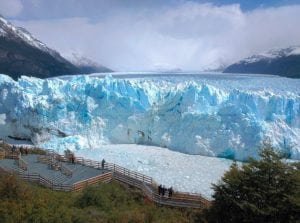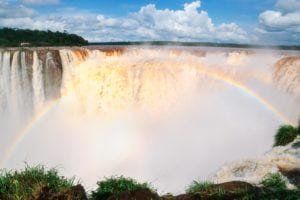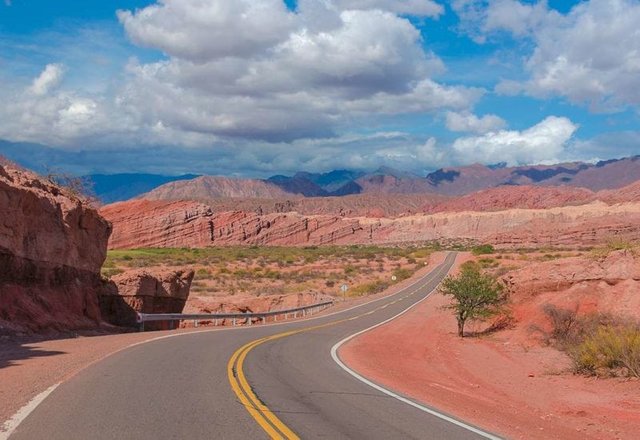Argentina Travel Guide | How to Do it Right
Argentina, which is officially known as the Argentine Republic, is a country on the South American continent. The whole land area of Argentina is approximately 2.7 million square kilometers, making it the 8th largest country in the world. Whether you choose to explore the country by car, bus, foot, or other ways you can imagine, Argentina is a massive task to cover.
One of the highlights of traveling around South America for me was renting a car in Buenos Aires and road-tripping throughout Argentina. If there's anywhere in the world you are going not to regret spending money on car rentals; it is here. You could technically get rental cars in the bordering Latin countries like Bolivia, Paraguay, and Uruguay; but it's more of a hassle, and you won't find it as easy as Argentina. If driving isn't your thing, then there are other ways to explore this beautiful country that we'll also cover in this guide.
What You Need To Know Before You Go
Visa Requirements
If you are a tourist with US, Canada, or Australian citizenship, you do not need a visa to travel to Argentina but have to pay the $160 reciprocity fee. That's because Argentines are required to pay this fee to enter the countries mentioned above. Some countries have exemptions to travel to Argentina like Russia. My wife (who's a Russian citizen) did not have to pay that fee while I had to. There is a 90 day limit of stay after which you have exit the country.
Internet
I found connectivity in Argentina lacking, and that pretty much goes for all the countries in South America. It's simple enough to have WiFi hotspots in hotels and hostels, but they're often slow. Much slower than their European counterparts. On the plus side, you can find that almost every restaurant or coffee shop offers free WiFi access to clients.
Crime
The Crime rate in Argentina is quite significant for petty theft. However, it's relatively safe for backpackers and even solo female travelers. Taxi scams are common in major cities. Trust your instinct and be smart. Always make copies of your travel documents in case you lose them. Buy good travel insurance for a piece of mind! It's important to take proper precaution when traveling to Argentina.
Power Adapters
The standard sockets used in Argentina are 220 and 240 volts. Use a plugin adapter when you're traveling from a country with a different electrical outlet.
Food
Argentina is famous for its meat and barbecue, or Asada. Chimichurri is a green salsa that's slightly tangy and is often served with steaks and meats. Empanadas are also famous; they are pastries filled with a sweet or savory filling then baked or deep-fried. The climate favors growing a variety of grapes, so wine is also good in Argentina.
Perito Moreno Glacier
 Perito Moreno Glacier
Perito Moreno Glacier
Part of the Los Glaciares National Park, located in the province of Santa Cruz, the Glacier is one of the most famous destinations in Patagonia. The glacial field is the third largest freshwater reserve in the world.
You can easily get there by car or by bus, and it's one you shouldn't miss. I highly recommend you hike it and take a tour guide with you. Check out the Tour section of this guide my recommendations.
Capital Buenos Aires
The city of Buenos Aires has temperate weather and somewhat cool and dry in the winter. I was there during summer, and it was humid and hot like the Philippines, a tropical place. I also spent a winter there, and it was cool, which I preferred.
Airport
The Ezeiza International Airport, or Ministro Pistarini, is the primary international airport in Argentina. It lies 14 miles south-southwest of Buenos Aires. I found a good deal using some apps on my phone, and you can also see it on specific days.
Patagonia
In the summertime, you can expect warm days and a couple of rainy or cold days. The geographic diversity in Argentina can be attributed to the climate of the area, which may lead to extreme temperatures, rain, and sunlight. The best time to see Patagonia is from October to March. But, you can expect the weather in Patagonia to be erratic.
Iguazu National Park
 A trip to Argentina is never complete without taking the time to drop by Iguazu National Park and Iguazu Falls. A UNESCO World Heritage Site, Iguazu National Park covers a total land area of 550 square km (212 square miles). Founded in 1934, the park showcases the natural beauty of Argentina, particularly the subtropical jungle it covers.
A trip to Argentina is never complete without taking the time to drop by Iguazu National Park and Iguazu Falls. A UNESCO World Heritage Site, Iguazu National Park covers a total land area of 550 square km (212 square miles). Founded in 1934, the park showcases the natural beauty of Argentina, particularly the subtropical jungle it covers.
In this park, you'll find various species of fauna and flora. Iguazu waterfall divides the upper and lower parts of the river. The river also flows through Brazil although a large proportion of the river and falls belong to Argentina.
Cost of Travel
Argentina is not particularly cheap. You can expect to spend $50 a day on average if you're backpacking and twice that if you're doing it with some luxury. I rented a flat in Palermo for a month at almost $1200 and some change that included all fees.
Money Saving Tips
- Travel off-season. Summer in Argentina, especially Buenos Aires is humid and hot. Winters are mild and much more pleasant.
- Camp where you can. If you're out in Patagonia the refugios are expensive and hostels even more. Pitch a tent if you have one with you.
- Buy wine in grocery stores. Wine is great in Argentina! I bought gallons of box wine there, and the quality was terrific!
- Couchsurfing is common and welcomed so do it when you can.
- Domestic flights are expensive, so travel by car or bus whenever possible.
- Take an overnight bus and save on a night's worth of accommodation.
- Carry cash into the country; it's much cheaper than taking it out on the exchange or ATMs.
Recommended Places To Stay in Argentina
Buenos Aires
- Sato Hostel - Great hostel in Palermo
- Milhouse Hostel - Close to the city center
San Carlos de Bariloche
- Hotel Eco - Located at the heart of Bariloche
- Cabaña Tibor - Offering lake views
Mendoza
-
Departamento céntrico - Minutes from the city center
Puerto Iguazú
- Hostel Damaris -Best value in Iguazu
Ushuaia
- Los Calafates B&B - Offering free breakfast and clean beds
Cafayate
- Hostel Casa Arbol - Cozy hostel with free breakfast
How to Rent A Car in Argentina
 It's a good idea to book a vehicle in advance, particularly for those who have a car preference or if you're traveling in high season. Be sure you hire from a reputable car hire firm; there are many horror stories online from small vehicle hire places.
It's a good idea to book a vehicle in advance, particularly for those who have a car preference or if you're traveling in high season. Be sure you hire from a reputable car hire firm; there are many horror stories online from small vehicle hire places.
You should always, inspect your rental car thoroughly before driving off to ensure that the rental company accurately notes all scratches and problems. It's a fantastic idea to take photos of any bumps and scrapes also, to cover yourself.
There are long distances between destinations and even fewer gas stations in between. Check with the car rental company where you can fill up, and then ensure that you do, even if you still have half a tank. On the northern route, Tilcara has the only gas station around for miles, so don't drive on past it.
There are lots of police checkpoints along the roads, especially when crossing between Salta and Jujuy provinces. Keep all of your paperwork close at hand in case.
Check your itinerary with the car hire company before leaving, especially during the rainy season. Also, during the Dakar Rally period, some roads and streets might be closed so plan accordingly.
It usually isn't difficult to show up in the tiny towns without accommodation already booked, but if you are traveling in January and February, during Carnival period, it is essential to book ahead as the cities host highly popular festivals and resorts and hostels fill up very fast.
STEP 1
Plan your routes, making sure you understand how much you have to travel. This is vital because most rental agencies in Argentina do not offer unlimited miles or kilometer. In fact, the majority of rentals offer you a maximum of 200 kilometers every day. As a result, you could incur extra charges for going over the daily limit.If you're planning to do a lot of driving while in Argentina, make sure you lease a car that does not charge by the distance.
STEP 2
Compare prices online and then book together with the agency that provides you the best bargain. Based on where you intend to visit, there are numerous rental agencies in the country. One car rental company I recommend is Discover Car Hire, which will aggregate all your rental searches from all car rental companies. Another place to look is Economy Bookings, which will help you find cheap car rentals around the world.
STEP 3
Compare prices from a person when you arrive in your place to find out if you're able to get a much better deal. If you discover a better price, do not be afraid to use that as leverage to get your rental service to coordinate with the price. It is not uncommon for tourists to ask for lower prices on car rentals. This is because leasing a vehicle in Argentina isn't cheap, as it may average up to $60 a day.
STEP 4
Carry the right paperwork and documents with you at all times. Including a valid driver's license, car registration and proof of insurance. Given the many checkpoints from Argentina, it is not unusual for the local police to stop motorists and inquire for various documents.
Exploring Argentina By Car Itineraries
Mendoza Itinerary
Mendoza is most famous for its acclaimed wineries surrounded by Andean peaks, but there's plenty to do in the area that does not involve grapes. The city is a university town with lots of lively bars and restaurants attracting a younger audience.
During your visit to Mendoza, we suggest driving out to the famous wineries of Norton, Ruca Malen, and Trapiche for lunch and wine.
Then, drive to Aconcagua (22,840ft/6960m) the tallest mountain outside of Asia, and the maximum peak in the southern hemisphere.
For a mere US $1.30 1.30, can access the park up until the trailhead, which makes it possible for you about two hours of hiking.
In the end, when you've eaten, sipped, and improved your way around Mendoza, it's time to relax. Drive to the Termas Cacheuta, about 90 minutes from town.
Lake District Itinerary
Patagonia's Lake District is just that a district full of gorgeous lakes. It's a remarkably scenic area, perfect for exploring by car.
There are many paths you can take, but here is our suggested itinerary: From Bariloche head to Circuito Chico then spend half a day in Limay River, then a day in Villa La Angostura, a day in San Martin de Los Andes, a day in Lake Lolog, and finally back to Bariloche.
Highlights of the road trip include:
- Bariloche and the beautiful lakes.
- Hikes around Lake Nahuel Huapi and Correntoso Lake in Villa La Angostura.
- Lanin National Park.
- San Martin de Los Andes.
Salta Itinerary
The vast assortment of places across this large area means there is a wide selection of routes, based on how much time you have. You can even choose to stick to the safer tarred highways, or throw caution to the wind and hit the gravel roads.Go straight to Purmamarca on day 1 and spend the night there to soak in the breathtaking vistas of this unbelievable Cerro de Siete Colores. Get up early the next day and journey to the spellbinding Salinas Grandes, before backtracking northwards to Humahuaca, where you will spend your second night. Then head out to explore the Quebrada de Humahuaca, a valley famous for its brightly colored hills and long history predating the Inca Empire.
Highlights of this area include:
- Museums, architecture, parks, plazas, and restaurants in Salta City.
- Quebrada de las Conchas National Park on the drive from Salta to Cafayate.
- The amazing wineries are surrounding Cafayate.
- Quebrada de las Flechas.
- The colorful mountains in Purmamarca.
- The blindingly white Salinas Grandes.
Highlights like La Garganta del Diablo and El Anfiteatro are clearly signposted along the road. The town of Cafayate itself is a charming place set in the center of Salta's high-altitude wineries; a place to indulge in some exquisite wine-tasting and enjoy some terrific hikes.
Patagonia Itinerary
One could argue that the Chilean side of Patagonia is the one to visit but don't discount what the Argentian side has to offer. But don't fret, renting a car will give you the freedom to explore both! You will have the freedom to stop and go as you please whilst enjoying the views. You should stop first at Bariloche then after exploring the small cozy town pack up for an easy 6-mile trek to Refugio Frey, where tasty empanadas and home-brewed beer awaits along with views of the Toncek Lagoon.
Note: if you want to drive your rental car over the border from Argentina into Chile, you'll need written permission from the leasing company and the best insurance to do so. Speak to the car rental agent before trying to cross, or you'll be turned away in case you don't have the correct documents.
Many places in Argentina are desert, and you will often find yourself out in the middle of nowhere, which is great if you're properly prepared. This means having a full tank of gas, first-aid kit, a spare tire, tools, a map, data plan on your telephone, a Spanish translation app or phrasebook, plus non-perishable food and plenty of drinking water.
Alternatives To Driving and Car Rental
Train
The railroad network in Argentina spans a total of 47,000 kilometers and ranks 8th in the world. However, due to the expansion of roads in the country, there was a sharp decline of its construction.Buses
Argentina has an extensive bus network. There are several comfort options for long-distance travel such as "cama" seats that recline to a bed position. Food is often served on board as well as wifi and booze. Fares vary, for example, from Buenos Aires to Mendoza it's under $40 while a trip from Bariloche to El Calafate will net you over $100.
Guided Tours vs. Doing it Yourself
Moreover, what you gain in the liberty to travel at your own pace, you lose from the penetration a tour guide can provide you on local culture and history. If you are really interested in learning more about Argentina, a guided tour might be your best option.
There are a lot of day tours operating out of Buenos Aires and other cities. Guided tours and trips are a great alternative if you don't have a lot of time in the location or if you wish to sit back and take in the scenery whilst learning from an expert local guide.
Recommended Tours
From El Calafate:
From Buenos Aires: From Salta: Other Tours: Orginally posted at Always Wanderlust Argentina Travel Guide
Hello adonisabril!
Congratulations! This post has been randomly Resteemed! For a chance to get more of your content resteemed join the Steem Engine Team
That's interesting, showing the manmade as well.
Posted using Partiko Android
nice guide, i am planning to go in Argentina next year
Posted using Partiko Android
Great place Argentina!
Thanks a lot, I saved the information! 🙏🏼